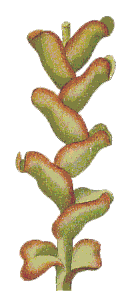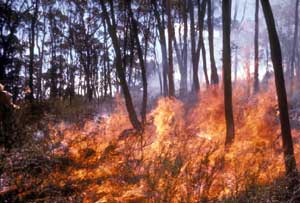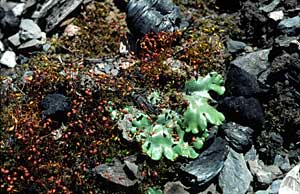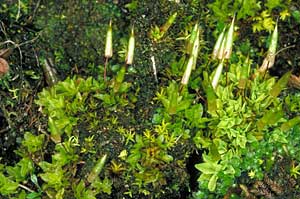
Bryophyte Ecology
Fire
The behaviour and effects of fire vary, depending on factors such as the general habitat, vegetation, topography and weather patterns. A low intensity fire may cause very little damage and possibly only in patches so that there is very little change in soil chemistry or vegetation cover. In these circumstances the bryophytes and vascular plants of the surrounding area are likely to re-colonize the burnt areas, with little, if any, change to the mix of vegetation in the area. An exception may occur on heathland or moorland where re-colonization by vascular plants can be slow, so allowing more extensive bryophyte growth.
A severe fire leaves a barren landscape and will have destroyed the surface leaf litter as well as much of the organic material in the upper soil level. This will have led to the destruction of many of the seeds and spores that had been present before the fire. Such a devastating fire sets the scene for initial re-colonization by bryophyte species which may have been rare (or even absent) before the fire. This page will concentrate on descriptions of what happens after such severe fires.
The bulk of studies about post-fire bryophytes have concentrated on investigating bryophyte re-colonization of the soil, with little reported about colonization of burnt wood. The bulk of this page will deal with soil bryophytes, with some comments about burnt wood near the end. While fire is destructive it also creates opportunities for various bryophytes. That's the subject of the final section on this page.
The paper mentioned in the reference button surveys the literature about post-fire bryophytes. While it doesn't include every publication on the subject, the bibliography does supply numerous references for anyone interested in following up this subject![]() .
.
We will shortly look at a study of bryophyte colonization of burnt areas in Tasmania. The exact results of this study will not necessarily hold in other areas, whether in Australia or overseas. The many studies about bryophytes and fire have shown that the exact behaviour of bryophytes in a burnt landscape depends greatly on local conditions. However, the Tasmanian study is a good illustration of the broad features of bryophyte re-colonization after fire and similar processes have been observed in other countries. After the summary of the Tasmanian study there'll be some comments about how the Tasmanian observations compare with studies from elsewhere in the world.
But first .... a statistical warning
In this page you'll see a few numbers that have been produced during studies about post-fire bryophyte growth. These numbers are all based on sampling parts of burnt areas, not from a thorough examination of every square centimetre of burnt ground. Because the numbers are based on samples they have some uncertainty associated with them. If you want to find out something about the degree of uncertainty you'll need to follow up the original sources given in the reference buttons. For the moment the important thing to remember is that when a figure such as 50% is used below, it really means "somewhere near 50%". Perhaps it should really be 45% or 60% or something else. Use the figures as reasonable guides to the behaviour of bryophytes out there in the burnt world, but don't believe them down to the last percent.
The Tasmanian study
In 1979 two researchers studied post-fire bryophyte recolonization in several Tasmanian logging coupes. Three identifiable bryophytes had colonized the burnt ground within the first few months after fire. Those three are the thallose liverwort Marchantia berteroana and the mosses Funaria hygrometrica and Ceratodon purpureus. Within six months Marchantia and Funaria together had covered about a third of the soil area. Ceratodon coverage increased dramatically in the second six months, at the expense of Marchantia and Funaria, and kept increasing for another year, reaching about 60% of the soil area. Then Ceratodon coverage lessened as the moss Polytrichum juniperinum increased the area it occupied. Three and a half years after the fire Polytrichum covered about 50% of the soil area. By that time some other mosses had also made readily noticeable appearances (three species of the genus Campylopus, mostly Campylopus introflexus ![]() , as well as Bryum sauteri and Tortella calycina ).
, as well as Bryum sauteri and Tortella calycina ).
Burnt ground accounted for about 30% of the surface in the study area, the rest being charred wood, burnt tree ferns and rocks. Those substrates were colonised more slowly than the burnt ground and not as extensively. Ceratodon purpureus was consistently the most prominent species. The leafy liverwort Cephaloziella exiliflora became conspicuous on the charcoal surfaces of burnt wood during the third year.
The details are in the TASMANIAN RECOLONIZATION CASE STUDY.
The pioneer species
In the Tasmanian study the first few months after fire saw three bryophytes appear: the thallose liverwort Marchantia berteroana and the mosses Funaria hygrometrica and Ceratodon purpureus. Marchantia berteroana is a Southern Hemisphere species, widespread in Australia and also known from New Zealand, Heard Island, Norfolk Island and South America. In northern hemisphere studies it is the species Marchantia polymorpha that is recorded on burn sites. That species is known from parts of Australia, as an introduction from Europe, but has not been reliably recorded after fire in Australia![]() .
.
Funaria hygrometrica ![]()
![]() is a cosmopolitan moss and has been reported as common after fire in Africa, Asia, Europe and North America as well. It can be found in non-burnt areas, in locations as diverse as suburban gardens, muddy banks beside creeks or rivers, in the cracks of retaining walls and dry and wet sclerophyll forests. Going by personal observation in Canberra it is a very common moss in pot plants for sale in nurseries. In unburnt areas this moss is found in small numbers, not the carpet-like swathes with which it can cover burnt ground. Ceratodon purpureus is another cosmopolitan species which, like Funaria hygrometrica, is also found on unburnt sites. Moreover, Ceratodon can do quite well on unburnt sites, more so than Funaria which is a much poorer competitor against other species.
is a cosmopolitan moss and has been reported as common after fire in Africa, Asia, Europe and North America as well. It can be found in non-burnt areas, in locations as diverse as suburban gardens, muddy banks beside creeks or rivers, in the cracks of retaining walls and dry and wet sclerophyll forests. Going by personal observation in Canberra it is a very common moss in pot plants for sale in nurseries. In unburnt areas this moss is found in small numbers, not the carpet-like swathes with which it can cover burnt ground. Ceratodon purpureus is another cosmopolitan species which, like Funaria hygrometrica, is also found on unburnt sites. Moreover, Ceratodon can do quite well on unburnt sites, more so than Funaria which is a much poorer competitor against other species.
The first few months (or even the year) after a fire are considered the colonising period, during which the pioneer species establish themselves. One conclusion from the many studies around the world is that one or more of a Marchantia species ![]() , Funaria hygrometrica and Ceratodon purpureus will usually constitute the pioneering post-fire species. Most commonly all three will occur, albeit with variation in which is the most dominant. In the Tasmanian burnt sites Funaria hygrometrica never equalled the coverage attained by Marchantia berteroana. By contrast, in some northern hemisphere studies Funaria hygrometrica has been recorded as the dominant pioneer, post-fire bryophyte. Several French researchers carried out a 10-year study of heathlands in Brittany which had been burnt by severe fires in the summer of 1976. In these heathlands, with several distinct micro-habitats, Funaria hygrometrica and Certaodon purpureus were the pioneering bryophytes in all sites, except in a Sphagnum bog within the researchers' study area. In this bog neither Ceratodon nor Funaria appeared, Marchantia was rare throughout the study area during the 10 years.
, Funaria hygrometrica and Ceratodon purpureus will usually constitute the pioneering post-fire species. Most commonly all three will occur, albeit with variation in which is the most dominant. In the Tasmanian burnt sites Funaria hygrometrica never equalled the coverage attained by Marchantia berteroana. By contrast, in some northern hemisphere studies Funaria hygrometrica has been recorded as the dominant pioneer, post-fire bryophyte. Several French researchers carried out a 10-year study of heathlands in Brittany which had been burnt by severe fires in the summer of 1976. In these heathlands, with several distinct micro-habitats, Funaria hygrometrica and Certaodon purpureus were the pioneering bryophytes in all sites, except in a Sphagnum bog within the researchers' study area. In this bog neither Ceratodon nor Funaria appeared, Marchantia was rare throughout the study area during the 10 years.
The pioneer species typically show a rise in their coverage of the soil and then a drop in area, as other species take over. The rates at which pioneer species gain and lose area vary, even within a species, as you can see in the CERATODON PURPUREUS CASE STUDY![]() .
.
In some circumstances none of Marchantia, Funaria or Ceratodon occur, or do so insignificantly, as shown in a New Zealand peatland. The area was south-east of Invercargill, at the southern end of the south island. The burnt areas had been covered by six vegetation communities, summarised by the following descriptive phrases:
- Mixed bog with Baumea tenax (a sedge), Gleichenia dicarpa (a fern), Empodisma minus (a rush) and shrubs
- Leptospermum scoparium scrub
- Pteridium esculentum fernland
- Sphagnum bog
- Chionochloa rubra grassland
- Ulex europaeus (European gorse) scrub
Apart from Sphagnum the listed species in those phrases above are vascular plants. The area was studied for ten years, starting after a fire in 1985. Sampling sites were chosen so that the recovery in each of the six communities could be assessed. Marchantia berteroana occurred in each of the recovering communities, but with greatly varying results. It was most prominent in the recovering Leptospermum scrub, reaching a coverage estimated at 45% after 15 months, dropping to about 17% after 39 months and to under 1% after 120 months, by which time Leptospermum scoparium cover had reached about 65%. In the burnt Pteridium fernland and Sphagnum bog sites Marchantia berteroana cover never exceeded 3% and in each of the remaining three recovering communities this liverwort failed to reach 1% cover. Neither Ceratodon nor Funaria was recorded at any time from any of the areas![]() .
.
Succession
From the Tasmanian study you will have noticed the change in bryophyte composition over time. The coverage by Marchantia, Funaria and Ceratodon shrinks and the coverage by other species increases. Polytrichum juniperinum has become dominant at the 42-month mark and mosses in the genus Campylopus are now easily noticeable. This phenomenon of succession is common in all severely burnt sites around the world but with variation in the species involved. In the post-fire succession vascular plants and lichens also play a role. You saw this in the brief account of the New Zealand heathland study where, over a 10-year period, Leptospermum scoparium re-established itself in what had been Leptospermum scoparium scrub before the fire. In the succession bryophytes, lichens and vascular plants are competing for resources. The results of these competitions are varied, often depending on local conditions.
Whereas it is possible to say that the pioneer bryophytes are mostly Ceratodon, Funaria and Marchantia it is not possible to summarise the successional bryophytes so simply. There are far more post-pioneer than pioneer species but one fairly general observation is possible. The genus Polytrichum usually appears after the pioneer species, regardless of vegetation type, and often becomes the dominant bryophyte for a significant period of time. The species involved are Polytrichum commune, Polytrichum formosum, Polytrichum juniperinum and Polytrichum piliferum. Of course, as you'd expect by now, there has to be an exception. In the New Zealand heathland study, mentioned a little earlier, Polytrichum commune appeared in two of the six vegetation communities. However, this moss failed to reach a coverage of 1% in either of these areas.
As well as variation in which bryophytes appear after the pioneer species there is also variation in the behaviour of these later arrivals. As an example of this consider the genus Polytrichum. The time after fire at which Polytrichum appears is variable, mostly between one and four years (but occasionally earlier or much later) and that variation in timing occurs even within species, not just between species. Moreover, in one English study of the recolonization of an experimentally burnt area the species Polytrichum commune and Polytrichum juniperinum, appeared but only at the edges of the burnt site, rather than within the burnt area.
The moss genera Bryum, Campylopus and Tortella appeared in Tasmania and other post-fire studies have also reported these genera, in particular Bryum, with eleven species noted. European studies have shown various tuber-forming Bryum species in the later post-fire succession. Other moss genera that have been reported in post-fire studies are: Barbula, Buxbaumia, Cheilothela, Dicranella, Didymodon, Encalypta, Leptobryum , Leucobryum, Pleurochaete, Pohlia, Pseudocrossidium, Trematodon, Trichostomum and Weissia.
In the Tasmanian study Marchantia appeared early and was the only liverwort noted, except for the appearance of Cephaloziella exiliflora on burnt logs in the third year. Typically, when you read post-fire studies you'll see more mosses than liverworts mentioned. The New Zealand heathland study recorded the thallose liverwort genus Riccardia from five of the six vegetation types and the leafy liverwort genus Teleranea from three. For each of these genera maximum coverage was about 5%, and not in all vegetation types in which they occurred. The thallose liverwort genera Fossombronia and Riccia have also been reported in post-fire studies![]() .
.
Here's another story, about what happened after a fire in Michigan in the USA in 1926:
- 1930 First observation of Ceratodon purpureus
- 1940 Ceratodon purpureus covered 50% of the ground
- 1942 Polytrichum piliferum appeared
- 1950 Ceratodon purpureus coverage was 95%
- 1971 Polytrichum piliferum and lichens (genus Cladonia) had virtually replaced Ceratodon
It is interesting to compare the behaviour of Ceratodon over time at this site with the results shown by the TASMANIAN RECOLONIZATION and CERATODON PURPUREUS case studies ![]() .
.
Burnt wood
There seems to have been little investigation of bryophyte colonization of burnt wood. The leafy liverwort Cephaloziella exiliflora has already been mentioned as a colonizer of charred wood. Bryologists well know to check burnt logs if they are looking for this liverwort and other species of Cephaloziella are also known from charred wood. The researchers of the Tasmanian study, described earlier on this page, found some of the post-fire soil mosses on burnt wood, with Ceratodon purpureus consistently the most prominent. However, colonization was slower on wood. This conclusion is supported by observations from southern Finland where some charred log surfaces are still largely bare even a century after fire. Mosses in the genus Dicranum and the leafy liverwort Ptilidium pulcherrinum have also been recorded on burnt wood![]() .
.
![An Australian Government Initiative [logo]](/images/austgovt_brown_90px.gif)




